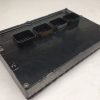Is Your 2006 Caravan or Town & Country Running Rough?
If you’re dealing with frustrating issues like intermittent stalling, a persistent check engine light, or erratic engine behavior, a faulty Engine Control Module (ECM) is often the culprit. The ECM is the central brain of your vehicle, managing everything from fuel injection and ignition timing to transmission shifting. When it starts to fail, it can create a cascade of confusing problems that are difficult to diagnose. This direct-fit replacement 2006 Caravan Engine Computer is the definitive solution to restore your minivan’s reliability and performance.
From the Diagnostic Bay
We recently had a 2006 Town & Country come into the shop that was giving its owner fits. The van would randomly stall at traffic lights and occasionally refuse to start. The owner had already replaced the spark plugs, ignition coil, and even the crankshaft position sensor, but the problem persisted. After hooking up our professional scan tool, we noticed intermittent communication loss with the ECM. We swapped in a known-good, programmed module, and the van ran perfectly. The original ECM had failing internal circuits that would act up as the unit heated up, causing the ghost-like issues the owner was chasing. It’s a classic case where throwing parts at the problem costs more than correctly diagnosing a faulty computer from the start.
Common Symptoms of a Failing ECM
- ✔ Persistent Check Engine Light (CEL) with communication-related fault codes (U-codes).
- ✔ Engine stalls unexpectedly, especially when warm or at idle.
- ✔ Vehicle cranks but refuses to start.
- ✔ Noticeable decrease in fuel economy and poor engine performance.
- ✔ Harsh or erratic automatic transmission shifting.
- ✔ Misfire codes that persist even after replacing plugs, wires, and coils.
- ✔ The cooling fans run constantly or not at all.
The Plug-and-Play Solution for Your 2006 Caravan Engine Computer
Don’t waste time and money at the dealership with expensive diagnostic fees and programming charges. We take the guesswork out of the repair. This Engine Control Module arrives at your door fully programmed to your vehicle’s specific Vehicle Identification Number (VIN) and current mileage. This ensures that all vehicle-specific data, including anti-theft information (SKIM), is correctly configured. The result is a simple, plug-and-play installation process. Simply disconnect the battery, swap the modules, reconnect the battery, and start your engine. No additional programming or dealer visits are required.
This module is a direct replacement for a wide range of original part numbers, ensuring compatibility and proper function for your 2006 Dodge Caravan or Chrysler Town & Country equipped with either the 3.3L or 3.8L engine. By providing us with your VIN, you guarantee a component that is perfectly matched to your vehicle’s factory specifications.
Frequently Asked Questions
Is this engine computer truly plug-and-play?
Yes. We program the module with the VIN and mileage you provide during checkout. This ensures it communicates perfectly with your vehicle’s other systems right out of the box, with no need for a trip to the dealer for additional programming.
Where is the ECM located on my 2006 Caravan?
The Electronic Control Module is typically located on the driver’s side (LH) fender in the engine bay. It’s an aluminum box with three large electrical connectors.
What information do you need from me to program the module?
We require your vehicle’s 17-digit Vehicle Identification Number (VIN) and the current mileage. You can typically find the VIN on your driver’s side dashboard (visible through the windshield) or on your vehicle’s registration or insurance card.
Do I need to return my old, faulty computer?
This purchase does not require a core return. You can keep or responsibly recycle your old module without any additional charges or hassle.
Can a bad ECM cause transmission problems?
Absolutely. The ECM works in tandem with the Transmission Control Module (TCM), often integrated into the same unit on these models. A failing ECM can cause incorrect shift commands, leading to harsh shifting, getting stuck in gear, or a complete failure to shift.


